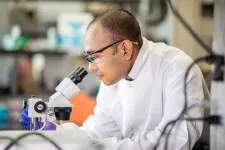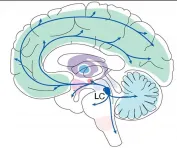Tweezers of sound can pick objects up without physical contact
Hemispherical array of ultrasound transducers lifts objects off reflective surfaces
2021-07-24
(Press-News.org) Tokyo, Japan - Researchers from Tokyo Metropolitan University have developed a new technology which allows non-contact manipulation of small objects using sound waves. They used a hemispherical array of ultrasound transducers to generate a 3D acoustic fields which stably trapped and lifted a small polystyrene ball from a reflective surface. Although their technique employs a method similar to laser trapping in biology, adaptable to a wider range of particle sizes and materials.
The ability to move objects without touching them might sound like magic, but in the world of biology and chemistry, technology known as optical trapping has been helping scientists use light to move microscopic objects around for many years. In fact, half of the 2018 Nobel Prize for Physics, awarded to Arthur Ashkin (1922-2020) was in recognition of the remarkable achievements of this technology. But the use of laser light is not without its failings, particularly the limits placed on the properties of the objects which can be moved.
Enter acoustic trapping, an alternative which uses sound instead of optical waves. Sound waves may be applied to a wider range of object sizes and materials, so much so that successful manipulation is possible for millimeter-sized particles. Though they haven't been around for as long as their optical counterparts, acoustic levitation and manipulation show exceptional promise for both lab settings and beyond. But the technical challenges that need to be surmounted are big. In particular, it is not easy to individually and accurately control vast arrays of ultrasound transducers in real-time, and get the right sound fields to lift objects far from the transducers themselves, particularly near surfaces that reflect sound.
Now, Researcher Shota Kondo and Associate Professor Kan Okubo from Tokyo Metropolitan University have come up with a new approach to lift millimeter-sized objects off a reflective surface using a hemispherical array of transducers. Their method of driving the array does not involve complex addressing of individual elements. Instead, they split the array into manageable blocks and use an inverse filter that finds the best phase and amplitude to drive them to make a single trap at some distance from the transducers themselves. By adjusting how they drive the blocks over time, they can change the position of their target field and move the particle they have trapped. Their findings are supported by simulations of the 3D acoustic fields that are created by the arrays, and of course, by their experiments with a polystyrene ball, which speak for themselves (see the video).
Though challenges remain in keeping particles trapped and stable, this exciting new technology promises big advances towards transforming acoustic trapping from a scientific curiosity to a practical tool in the lab and in industry.
INFORMATION:
ELSE PRESS RELEASES FROM THIS DATE:
2021-07-23
At a glance:
Researchers studied cells collected by nasal swabs at the moment of diagnosis for both mild and severe COVID-19 patients
Cells taken from patients who went on to develop severe disease had a muted antiviral response compared to those who went on to develop mild disease
This suggests that it may be possible to develop early interventions that prevent severe COVID-19 from developing
The team also identified infected host cells and pathways associated with protection against infection that may enable new therapeutic strategies for COVID-19 and other respiratory viral infections
CAMBRIDGE, MA (July 23, 2021) -- Over the past 18 ...
2021-07-23
St. Jude Children's Research Hospital investigators have demonstrated that comprehensive genomic sequencing of all pediatric cancer patients is feasible and essential to capitalize on the lifesaving potential of precision medicine. Results from the St. Jude Genomes for Kids study appear online today in the journal Cancer Discovery.
Whole genome and whole exome sequencing of germline DNA was offered to all 309 patients who enrolled in the study. Whole genome, whole exome and RNA sequencing of tumor DNA was carried out for the 253 patients for whom adequate tumor samples were available.
Overall, 86% of patients had at least one ...
2021-07-23
MEADVILLE, PA - July 22, 2021 - Shark Week is many things. First and foremost, it's a week of shark-themed documentary programming on the Discovery Channel. Now in its 33rd year, it's the longest-running cable event in history. It's the biggest audience that marine biologists and ocean conservationists get, attracting millions of viewers who might otherwise not ever think about sharks at all. It's a stage that has launched careers of shark scientists and inspired many others to pursue jobs as ocean scientists.
However, a new analysis shows that Shark Week is also deeply flawed in ways that undermine its goals, potentially harming both sharks and shark scientists. To document just how pervasive ...
2021-07-23
Toronto -- People post 500 million tweets and 4 billion pieces of content on Facebook a day. What makes them do it?
An urge to share and connect with others seems obvious. But, despite how toxic the social media sandbox can get, people more often share attitudes that are framed in terms of support instead of opposition, according to new research. That happens regardless of whether the opinion itself is positive or negative.
Take gun control. The research found that people were likelier to express themselves on that issue in terms of, "I support allowing guns," or, "I support banning guns," versus, "I oppose banning guns," or, "I oppose allowing guns."
"There are a lot of controversial issues where both sides talk about what they support - pro-life and pro-choice on abortion, for example," ...
2021-07-23
Recently, a research group led by Prof. YUAN Kaijun and Prof. YANG Xueming from the Dalian Institute of Chemical Physics (DICP) of the Chinese Academy of Sciences revealed strong isotope effects in photodissociation of the water isotopologue (HOD) using the Dalian Coherent Light Source.
Their findings were published in Science Advances on July 23.
"Our experimental results illustrate dramatically different quantum state population distributions of OH and OD fragments from HOD photodissociation. The branching ratios of the H+OD and D+OH channels display large wavelength-dependent isotopic fractionation," said Prof. YUAN.
Because ...
2021-07-23
Research in mice, published today in Science Immunology by researchers at the Babraham Institute, UK and VIB-KU Leuven, Belgium, provides two solutions with potential to overcome a key clinical limitation of immune cell therapies. Regulatory T cells have potential in treating autoimmunity and inflammatory diseases yet they can switch from a protective to damaging function. By identifying the unstable regulatory T cells, and understanding how they can be purged from a cell population, the authors highlight a path forward for regulatory T cell transfer therapy.
Cell therapy is based on purifying cells from a patient, growing them up in cell culture to improve their properties, and then reinfusing them into the patient. Professor Adrian ...
2021-07-23
In the evolving field of cancer biology and treatment, innovations in organ-on-a-chip microdevices allow researchers to discover more about the disease outside the human body. These organs-on-chips serve as a model of the state an actual cancer patient is in, thus allowing an opportunity to finding the correct treatment before administering it to the patient. At Texas A&M University, researchers are pushing these devices to new levels that could change the way clinicians approach cancer treatment, particularly ovarian cancer.
The team has recently submitted a patent disclosure with the Texas A&M Engineering Experiment Station.
"We claim several novelties in technological ...
2021-07-23
A study by researchers at the Texas A&M University School of Public Health shows that inexpensive and convenient devices such as silicone wristbands can be used to yield quantitative air quality data, which is particularly appealing for periods of susceptibility such as pregnancy.
The research team found that the wristbands, when used as passive samplers, have the ability to bind smaller molecular weight semi-volatile polycyclic aromatic hydrocarbons (PAHs) -- a class of chemicals that occur naturally in coal, crude oil and gasoline and are produced when coal, oil, gas, wood, garbage and tobacco are burned -- in a similar pattern as active sampling.
Published recently in Nature's ...
2021-07-23
Small and seemingly specialized, the brain's locus coeruleus (LC) region has been stereotyped for its outsized export of the arousal-stimulating neuromodulator norepinephrine. In a new paper and with a new grant from the National Institutes of Health, an MIT neuroscience lab is making the case that the LC is not just an alarm button but has a more nuanced and multifaceted impact on learning, behavior and mental health than it has been given credit for.
With inputs from more than 100 other brain regions and sophisticated control of where and when it sends out norepinephrine (NE), the LC's tiny population of surprisingly diverse cells may represent an important regulator of learning from ...
2021-07-23
Alexandria, Va., USA - Hiba Nasir, Wayzata High School, Plymouth, Minn., presented the poster "Oral-Health Impact Profile 5: Analyzing A Private Practice Adult Population's Distribution" at the virtual 99th General Session & Exhibition of the International Association for Dental Research (IADR), held in conjunction with the 50th Annual Meeting of the American Association for Dental Research (AADR) and the 45th Annual Meeting of the Canadian Association for Dental Research (CADR), on July 21-24, 2021.
Nasir, a high school student, along with Sheila Riggs, University of Minnesota, Minneapolis, USA, performed an observational study to understand the ...
LAST 30 PRESS RELEASES:
[Press-News.org] Tweezers of sound can pick objects up without physical contact
Hemispherical array of ultrasound transducers lifts objects off reflective surfaces





